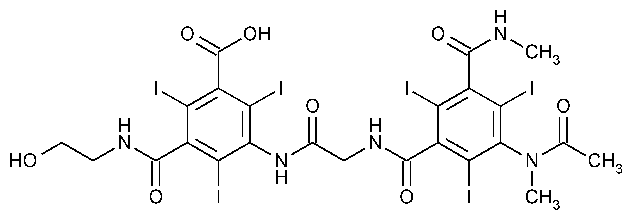Ioxaglic Acid
Benzoic acid,3-[[[[3-(acetylmethylamino)-2,4,6-triiodo-5-[(methylamino)carbonyl]benzoyl]amino]acetyl]amino]-5-[[(2-hydroxyethyl)amino]carbonyl]-2,4,6-triiodo-.
N-(2-Hydroxyethyl)-2,4,6-triiodo-5[2-[2,4,6-triiodo-3-(N-methylacetamido)-5-(methylcarbamoyl)benzamido]acetamido]isophthalamic acid [59017-64-0].
»Ioxaglic Acid contains not less than 98.5percent and not more than 101.5percent of C24H21I6N5O8,calculated on the anhydrous basis.
Packaging and storage—
Preserve in well-closed containers.Store at 25 ,excursions permitted between 15
,excursions permitted between 15 and 30
and 30 .
.
Identification—
A:Thin-Layer Chromatographic Identification Test á201ñ—
Test solution—
Dissolve 50mg in 5mLof methanol.
Application volume:
5µL.
Developing solvent system:
butyl alcohol,water,and acetic acid (50:25:11).
Procedure—
Proceed as directed in the chapter.The RFvalues of the two spots obtained from the Test solutioncorrespond to those obtained from the Standard solution.
B:
Heat about 500mg in a crucible:violet vapors are evolved.
Water,Method Iá921ñ:
not more than 5%.
Residue on ignition á281ñ:
not more than 0.1%,the residue being moistened with 2mLof 35%sulfuric acid and ignited at 600 .
.
Heavy metals—
Test solution—
Dissolve 2g of Ioxaglic Acid in 16mLof 0.1Nsodium hydroxide in a glass-stoppered 25-mLgraduated cylinder,dilute with water to 20mL,and mix.Transfer 15mLof this solution to a 50-mLcolor-comparison tube.
Standard solution—
Transfer 2.0mLof Standard Lead Solution(20µg of Pb)(see Heavy Metals á231ñ)to a 50-mLcolor-comparison tube,add 5mLof the Test solutionand 15mLof water,and mix.
Procedure—
Adjust the Test solutionand the Standard solutionwith 1Nacetic acid to a pHof between 3and 4.Add 1mLof a solution of sodium sulfide containing 1.16mg per mL,mix,allow to stand for 5minutes,and view downward over a white surface:the color of the solution from the Test solutionis not darker than that of the solution from the Standard solution(0.002%).
Free iodine and iodide—
Test solution—
Dissolve 2g of Ioxaglic Acid in 20mLof 0.1Nsodium hydroxide in a 50-mLcentrifuge tube.Add 15mLof 2Nsulfuric acid,mix on a vortex mixer,centrifuge for 15minutes,and decant the supernatant layer into a glass-stoppered 100-mLgraduated cylinder.Repeat the sulfuric acid washing and centrifugation twice more,decanting each supernatant layer into the 100-mLgraduated cylinder.
Procedure—
Add 5mLof toluene,shake vigorously,and allow the layers to separate:the toluene layer shows no red color.Add 1mLof sodium nitrite solution (1in 50),shake,and allow the layers to separate:any red color in the toluene layer is not darker than that obtained when a mixture of 2.0mLof potassium iodide solution (1in 4000),25mLof water,and 15mLof 2Nsulfuric acid is substituted for the Test solution(0.02%of iodide).
Assay—
Transfer about 500mg of Ioxaglic Acid,accurately weighed,to a glass-stoppered 125-mLconical flask,and add 12mLof 5Nsodium hydroxide,20mLof water,and 1g of powdered zinc.Connect the flask to a reflux condenser,and reflux for 30minutes.Cool the flask to room temperature,rinse the condenser with 20mLof water,disconnect the flask from the condenser,and filter the mixture.Rinse the flask and the filter thoroughly,adding the rinsing to the filtrate.Add 40mLof 2Nsulfuric acid,and titrate immediately with 0.05Nsilver nitrate VS,determining the endpoint potentiometrically,using silver-calomel electrodes and an agar–potassium nitrate salt bridge.Each mLof 0.05Nsilver nitrate is equivalent to 10.57mg of C24H21I6N5O8.
Auxiliary Information—
Staff Liaison:Andrzej Wilk,Ph.D.,Senior Scientific Associate
Expert Committee:(RMI)Radiopharmaceuticals and Medical Imaging Agents
USP28–NF23Page 1055
Pharmacopeial Forum:Volume No.29(6)Page 1911
Phone Number:1-301-816-8305
